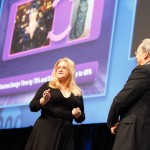Can’t wait for Oscar night? I know I can’t. So here at Hypergrid Business we’re doling out our own awards. First, a little video introduction. This is a little sailboat trip that OpenSim’s own Bri Hasp took across a few virtual worlds. Yes, it is now possible to sail a boat from one virtual world to another without logging in again.
Wasn’t that pretty? Maybe I’ll hold my next virtual staff get-together on the high seas instead of inside our virtual office building!
Now, without further delay, here are the first annual Maria Awards for enterprise uses of virtual worlds.
SEXIEST PROGRAMMER
Virtual worlds are pretty geeky, but there’s one developer who can always make my heart go patter-patter. Whether she’s talking about the multi-dimensional nature of the hyperverse, or the latest security implications of OpenSim, she gets us hyper-ventilating. I’m speaking, of course, about the inventor of the hypergrid, the Tim Berners-Lee of our generation, the famous, the glorious, Crista Lopes, also known as “Diva Canto.â€

At the beginning of 2009, each virtual world was a walled garden, an entity onto itself. Metaverse residents of different worlds were isolated from one another.
Then Lopes invented the hypergrid protocol, under which an avatar from one world could teleport to another. One by one, large and small OpenSim grids embraced the technology, allowing their users to travel freely through the metaverse. This is the real deal. True teleports — with your appearance, inventories, the whole shebang. But enabling hypergrid required tweaking OpenSim initialization files — not for the faint of heart.
So Lopes did even more. In the fall of 2009, she released the Diva Distro, which handles all the work of setting up and deploying a small private grid, with hypergrid automatically enabled. As a free extra, her distribution of OpenSim includes megaregions — meaning that border crossing are transparent. That’s right, you can walk across region borders without a single hiccup. But wait, there’s more. She also threw in an upgrade utility, taking the hassle out of upgrading to newer versions of OpenSim.
Today, there are hundreds of small, private grids running happily on the Diva Distro, including ours.
Why is this great for business? It’s great because you can have your own private company grid, and have your employees use company-owned avatars, and still be able to travel to other grids for meetings, client visits, networking, off-site training, and, of course, shopping for office furniture and collaboration tools. You get all the privacy and content controls available to the owner of a private grid, combined with all the benefits of being part of a large ecosystem of destinations, content, and service providers.
If that doesn’t make you swoon, then I don’t know… you’re dead inside, dude.
Lopes is a professor of informatics at the University of California, Irvine. She is also the cofounder of Metaverse Ink, a virtual worlds search engine covering OpenSim and Second Life grids.
- Read about her presentation at an Intel Keynote at the 2009 Supercomputing Conference.
- Watch a video in which she is interviewed at the same event.
- Watch a video demonstrating how to pilot a sailboat from virtual world to virtual world to virtual world.
- Watch a video showing how Lopes’ Diva Distro does away with region crossing problems — and makes hypergrid simple.
MOST RESPECTABLE DISTRIBUTION OF OPENSIM
Sure, the Diva Distro is sexy as all hell. But what if you’re a large corporation? You want the opposite of sexy. You want staid, boring, and predictable. You need something that comes with brand name backing, support contracts, and costs a great deal of money. How can any corporate executive take something seriously if its free?

So to the rescue comes IBM’s Lotus Sametime 3D product, also known as Virtual Collaboration for Lotus Sametime. For $50,000 — plus a service contract — you get the same OpenSim as the guys downloading it for free do. Plus, you also get pre-configured conference halls, offices, and other facilities and a bunch of collaboration products.
But wait, there’s more.
You also get back-end integration with your other Lotus Sametime products, with your corporate directory, and, if you wish, with enterprise resource planning systems or other heavy-duty stuff you’ve got running behind the scenes. And you get support from IBM, one of the companies instrumental in developing OpenSim.
- Official IBM page for Virtual Collaboration for Lotus Sametime, with demo video.
- Read article about the initial release of IBM Lotus Sametime 3D.
- Follow-up article with pricing and other details.
BEST COMMERCIALIZATION OF OPENSIM
Okay, so you’ve seen the two extremes. The free, do-it-yourself approach of the Diva Distro. The high-end corporate option from IBM. But in practice, if you’re a small or mid-sized company — or a small to mid-sized department in a large company — and you want to set up a virtual collaboration space for a reasonable amount of money? Something that won’t require approval from a series of vice presidents who think you’re trying to blow the company’s cash on video games?
You go with ReactionGrid. Prices start at just $25 a month — less than a tenth of what Second Life charges. And the folks who run the company — CEO Kyle Gomboy, COO Robin Gomboy, and CTO Chris Hart — are always on hand on their public grid to answer questions.
Although their primary focus is on educational clients and small businesses, Microsoft is a client as well.

They can set you up with a region on their PG-rated public, hypergrid-accessible ReactionGrid. Or they can create a private grid for you, either on or off the hypergrid. They also offer an OpenSim appliance, a pre-configured computer you buy, plug in behind your firewall, turn on, and — voila! — you’re running your own virtual world.
 CEO Kyle Gomboy |
 CTO Chris Har |
 COO Robin Gomboy |
With warm customer service, and a growing army of evangelical users, it’s no wonder that ReactionGrid has become the largest commercial grid in the OpenSim universe, with 229 regions as of a week ago. There are three larger grids, but all are non-profit, and all allow free connections from folks hosting their own regions.
- Read about the backgrounds of the founders.
- Read about their self-contained OpenSim appliance.
- Read about their hosting service.
BEST BOUNDARY-PUSHING
OpenSim is an evolving platform. And plenty of folks contribute to its evolution. (See the list of core developers here — thanks, guys! We love you!)

But if you want to see some really mind-blowing stuff, head over to ScienceSim. This Intel-backed grid recently ran a test in which they put 1,024 regions on a single processor, simulating Yellow Stone National Park. If you think that’s impressive, they’re also managing to fit over 200,000 primitives on a single region — though not a region sharing its processor with 1,023 others.
A primitive is a building block of virtual world construction. An average region typically holds around 5,000 primitives. Second Life regions max out at 15,000 primitives. OpenSim regions have no maximum limit — they can hold as many objects as the server can handle.
The woman behind this particular bit of boundary-pushing is Shenlei Winkler, CEO of the Fashion Research Institute. She’s also administering the ScienceSim Land Grand Program, under which educators and researchers can get free space on ScienceSim.
- Fashion Research Institute article about how the Yellow Stone National Park simulation was done.
- Watch Shenlei Winkler’s video about the Shengri La region in ScienceSim.
- Read article about how OpenSim can support hundreds of thousands of objects.
- Watch Intel video about using high bandwidth video in ScienceSim.
- Watch Intel video about using 3D simulations to visualize complex data.
BEST GRID
Obviously, the best grid for you is your own private grid. No matter how tiny and dinky, it’s still home sweet home. But when you leave your personal pocket universe, where do you go?
The number one destination? OSGrid.
If you’re looking for networking events, dance parties, shopping destinations, technical advice, or a shoulder to cry on, OSGrid is the cross-roads of the metaverse. At least, it is until Second Life joins the hypergrid.

At current writing, the non-profit OSGrid has over 5,000 regions — a sixth the land area of Second Life. It’s doubled in size since August, when it had only 2,500 regions. At this rate, OSGrid alone will be the size of Second Life in a little over a year from now. Of course, Second Life has a much higher population density. Land is expensive, so more people are packed into smaller areas. By comparison, OSGrid is almost deserted, home to artists, developers, builders and other folks looking for large, quiet spaces in which to create.
As a nonprofit, OSGrid has neither the budget nor the philosophical inclination to market itself to the outside world. People come by word of mouth, or through finding out about it on the Internet. Getting your own region on OSGrid is easy, even if you’re not particularly technically inclined. You can run Adam Frisby’s automated region launcher and host it on your own computer, or you can use one of many third-party vendors to run your region for you.
Compared to Second Life, the OSGrid community is much smaller, and also closer and more tight-knit. There’s a high percentage of technically inclined folks using their OSGrid regions to test the latest OpenSim release. OSGrid itself is at the cutting edge of development, and its management overlaps with the OpenSim open source development community quite a bit.
OSGrid is committed to respecting copyrights, and management has affirmed that it will remove offending items from the grid-wide inventory storage, and ban repeat offenders from the grid. There is also a low tolerance for griefing, disrespect, and sexually aggressive behaviors in public spaces. Of course, what you do on your own region is up to you.There are weekly office hours at which residents can raise issues, a 24/7 live IRC chat room, and active forums.
Businesses considering attaching all their company regions to OSGrid rather than running them as a separate grid should be aware, however, that OSGrid has an aggressive software update schedule. OpenSim is still alpha software, and is evolving quickly. New versions of the server code are occasionally incompatible with older versions, and region owners have to upgrade in order to remain attached to the grid. This can be an inconvenience, since a company might not have time to upgrade, and since the latest release isn’t necessarily the most stable. ReactionGrid, for example, tends to lag several releases behind OSGrid, since it’s primarily focused on having the most stable environment for its enterprise customers.
But, overall, OSGrid is a safe and comfortable environment for business visitors looking to hold networking events, buy office furniture, and meet developers and builders who might be hired to work on projects.
- OSgrid back online after extended maintenance - April 16, 2025
- Analysts predict drop in headset sales this year - March 25, 2025
- OSgrid enters immediate long-term maintenance - March 5, 2025
